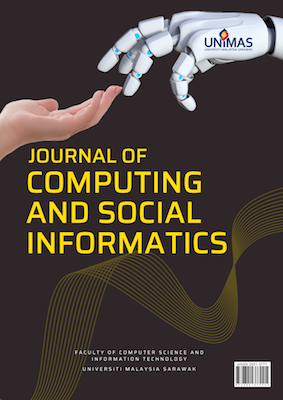Fraud Detection Model for Illegal Transactions
DOI:
https://doi.org/10.33736/jcsi.6449.2024Keywords:
Confusion Matrix, Financial Transaction, Credit Card, Fraud Detection, Machine LearningAbstract
Due to advancements in network technologies, digital security is becoming a top priority worldwide. This project aims to study how machine learning classifier such as random forest could be used to learn patterns in fraudulent and legitimate transactions in order to detect fraudulent transactions using Python programming language on Jupyter notebook as an Integrated Development Environment. Scikit-learn was used to develop algorithm, streamlit and heroku platforms for proper and efficient detection and classification of unauthorized transactions. This was incorporated into a web application that allows users to upload data that can be analyzed by the system to detect fraud. The Classification report and Confusion matrix have been used to evaluate each model’s accuracy. Random forest as a classifier model gave an accuracy of 99.95%. At the end of this study, a web-based application has been developed to upload data and detect fraudulent in online based transactions.
References
Benson S., Edwin R.A., & Annie P. (2020). Analysis on credit card fraud detection methods. International Conference on Computer, Communication and Electrical Technology (ICCCET), IEEE, 42(2), 152-156.
Berk, R. J. (2019). What You Can and Can’t Properly Do with Regression. Journal of Quantitative Criminology, Springer, 5(3). 756-767.
David, U. (2021). Bureau of consumer financial protection consumer credit card market report, International Conference on Computer, Communication and Electrical Technology (ICCCET), 12, 15-22.
Hand D. J. (2019), Fraud Detection in Telecommunications and Banking: Discussion of Becker, Techno metrics, 52(1), 34-38.
Maniraj, S. P., Aditya S., Shadab A. and Swarna S. (2019). Credit Card Fraud Detection using Machine Learning and Data Science, International Journal of Engineering Research, 8(2), 56-64.
Mareeswari,V. (2019). Prevention of Credit Card Fraud Detection based on HSVM. International Conference on Information Communication and Embedded System, 11. 33-47.
Mason, S. (2020). Looking at debit and credit card fraud. Teaching Statistics,34(3),87-9.
Melo-Acosta, G.E. (2020). Fraud Detection in Big Data Using Supervised and Semi-Supervised Learning Techniques, IEEE Colombian Conference on Communications and Computing, 2(1), 723-729.
Mohammed, E., & Behrouz F. (2019). Supervised Machine Learning Algorithms for Credit Card Fraudulent Transaction Detection: A Comparative Study, IEEE Annals of the History of Computing, 12(3), 82-93.
Shabad, M., & Kavitha, M. (2018). Credit Card Fraud Detection Using Neural Networks at Merchant Side, Journal of Computational and Theoretical Nanoscience, 15(4),3373-3375.
Shiyang X., Guan Jun L., Zhenchuan Li., Lutao Z., Shuo W., & Changjun J. (2019). Random forest for credit card fraud detection. IEEE 15th International Conference on Networking, Sensing and Control, 15, 23-38.
Srivastava, A., Kundu, A., Sural, S. & Majumdar, A. (2018). Credit Card Fraud Detection Using Hidden Markov Model. IEEE Transactions on Dependable and Secure Computing, 5(1),37-48.
Suvasini P., Amlan K., Shamik S., & Majumdarb A.K. (2019). Credit card fraud detection: A fusion approach using Dempster–Shafer theory and Bayesian learning. Information Fusion, 10 (4), 354-363.
Talabis, M. (2019). Information Security Analytics. Waltham: Syngress is an imprint of Elsevier, 5(1), 1-12.
Downloads
Published
How to Cite
Issue
Section
License
Copyright Transfer Statement for Journal
1) In signing this statement, the author(s) grant UNIMAS Publisher an exclusive license to publish their original research papers. The author(s) also grant UNIMAS Publisher permission to reproduce, recreate, translate, extract or summarise, and to distribute and display in any forms, formats, and media. The author(s) can reuse their papers in their future printed work without first requiring permission from UNIMAS Publisher, provided that the author(s) acknowledge and reference publication in the Journal.
2) For open access articles, the author(s) agree that their articles published under UNIMAS Publisher are distributed under the terms of the CC-BY-NC-SA (Creative Commons Attribution-Non Commercial-Share Alike 4.0 International License) which permits unrestricted use, distribution, and reproduction in any medium, for non-commercial purposes, provided the original work of the author(s) is properly cited.
3) For subscription articles, the author(s) agree that UNIMAS Publisher holds copyright, or an exclusive license to publish. Readers or users may view, download, print, and copy the content, for academic purposes, subject to the following conditions of use: (a) any reuse of materials is subject to permission from UNIMAS Publisher; (b) archived materials may only be used for academic research; (c) archived materials may not be used for commercial purposes, which include but not limited to monetary compensation by means of sale, resale, license, transfer of copyright, loan, etc.; and (d) archived materials may not be re-published in any part, either in print or online.
4) The author(s) is/are responsible to ensure his or her or their submitted work is original and does not infringe any existing copyright, trademark, patent, statutory right, or propriety right of others. Corresponding author(s) has (have) obtained permission from all co-authors prior to submission to the journal. Upon submission of the manuscript, the author(s) agree that no similar work has been or will be submitted or published elsewhere in any language. If submitted manuscript includes materials from others, the authors have obtained the permission from the copyright owners.
5) In signing this statement, the author(s) declare(s) that the researches in which they have conducted are in compliance with the current laws of the respective country and UNIMAS Journal Publication Ethics Policy. Any experimentation or research involving human or the use of animal samples must obtain approval from Human or Animal Ethics Committee in their respective institutions. The author(s) agree and understand that UNIMAS Publisher is not responsible for any compensational claims or failure caused by the author(s) in fulfilling the above-mentioned requirements. The author(s) must accept the responsibility for releasing their materials upon request by Chief Editor or UNIMAS Publisher.
6) The author(s) should have participated sufficiently in the work and ensured the appropriateness of the content of the article. The author(s) should also agree that he or she has no commercial attachments (e.g. patent or license arrangement, equity interest, consultancies, etc.) that might pose any conflict of interest with the submitted manuscript. The author(s) also agree to make any relevant materials and data available upon request by the editor or UNIMAS Publisher.

